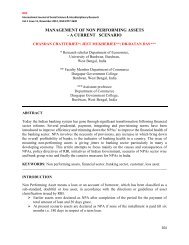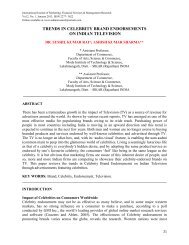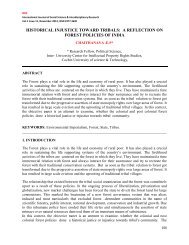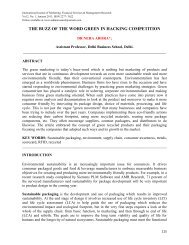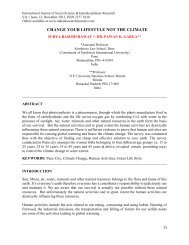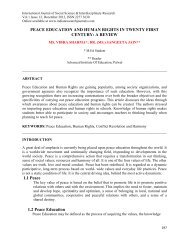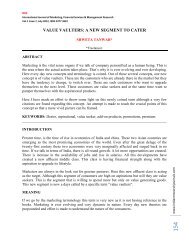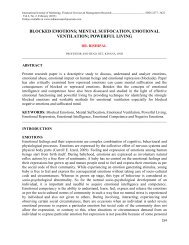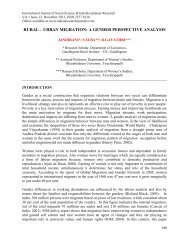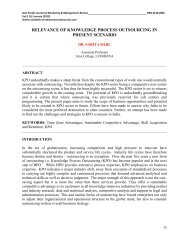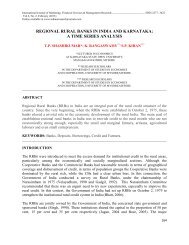teacher motivation and quality education delivery: a study of public ...
teacher motivation and quality education delivery: a study of public ...
teacher motivation and quality education delivery: a study of public ...
Create successful ePaper yourself
Turn your PDF publications into a flip-book with our unique Google optimized e-Paper software.
International Journal <strong>of</strong> Social Science & Interdisciplinary Research<br />
Vol.1 Issue 12, December 2012, ISSN 2277 3630<br />
Online available at www.indianresearchjournals.com<br />
established <strong>and</strong> since then <strong>education</strong> received a tremendous boost. Currently, the metropolis has<br />
a university campus. Apart from this, Tamale has a Polytechnic, two Teacher Training Colleges,<br />
Nursing Training College, <strong>and</strong> Community Health Training School, <strong>and</strong> School <strong>of</strong> Hygiene.<br />
Also, there are eleven (11) <strong>public</strong> senior high schools <strong>and</strong> seven (7) private Senior High Schools.<br />
In addition, there are two hundred <strong>and</strong> twenty eight (228) kindergartens (KGs), two hundred <strong>and</strong><br />
fifty seven (257) primary schools <strong>and</strong> one hundred <strong>and</strong> three (103) junior high schools (JHS).<br />
Apart from this, there are a total <strong>of</strong> one hundred <strong>and</strong> sixty seven (167) registered private basic<br />
schools in Tamale Metropolitan area (Tamale Metropolitan Education Office).<br />
Research Design: This <strong>study</strong> was a social survey, cross-sectional in approach <strong>and</strong> explanatory in<br />
content. It aimed at finding out about the state <strong>of</strong> <strong>teacher</strong>s <strong>motivation</strong> in Tamale metropolis <strong>and</strong><br />
to explain the relationship between <strong>teacher</strong> <strong>motivation</strong> <strong>and</strong> <strong>quality</strong> <strong>education</strong> <strong>delivery</strong>.<br />
Sampling Procedure<br />
Target Population: All the <strong>teacher</strong>s in the <strong>public</strong> basic schools, both primary <strong>and</strong> JHS, located<br />
in the Tamale Metropolitan Area were targeted for the <strong>study</strong>.<br />
Study Population: The <strong>study</strong> focused on only the <strong>teacher</strong>s <strong>and</strong> head <strong>teacher</strong>s from the selected<br />
basic schools in the metropolis. The <strong>study</strong> population was obtained from the schools selected for<br />
the <strong>study</strong>.<br />
Unit <strong>of</strong> Analysis: The individual <strong>teacher</strong>s <strong>and</strong> head<strong>teacher</strong>s constituted the sampling units for<br />
this <strong>study</strong>. In this <strong>study</strong> therefore, the <strong>teacher</strong>s‟ opinions <strong>and</strong> characteristics were sought to <strong>study</strong><br />
the <strong>motivation</strong>al levels <strong>of</strong> <strong>teacher</strong>s <strong>and</strong> its effect on <strong>quality</strong> <strong>education</strong> <strong>delivery</strong> in <strong>public</strong> basic<br />
schools in the Tamale metropolis <strong>of</strong> Ghana.<br />
Sampling frame: The list <strong>of</strong> all <strong>public</strong> basic schools <strong>and</strong> their <strong>teacher</strong>s constituted the sampling<br />
frame for the <strong>study</strong>. The list <strong>of</strong> schools was obtained from the Metropolitan Education Office in<br />
Tamale. Also, the list <strong>of</strong> <strong>teacher</strong>s was obtained from the various selected <strong>public</strong> basic schools.<br />
The sampling frame helped the researcher to choose a sample that was representative <strong>of</strong> the<br />
population being studied.<br />
Sample Selection <strong>and</strong> Sample Size: Stratified r<strong>and</strong>om sampling technique was used to select 20<br />
<strong>public</strong> basic schools with both primary schools <strong>and</strong> JHS from urban <strong>and</strong> peri-urban areas.<br />
Stratified sampling was used to ensure that the data was fairly representative <strong>of</strong> the views <strong>of</strong> the<br />
population. The total number <strong>of</strong> <strong>teacher</strong>s from the selected 20 <strong>public</strong> basic schools was 300.<br />
From tabulated values <strong>of</strong> different sample sizes, a population <strong>of</strong> 300 individuals requires a<br />
minimum sample size <strong>of</strong> 168 for a 95% confidence level at 5% margin <strong>of</strong> error (Saunders, Lewis<br />
<strong>and</strong> Thornhill, 2009). Therefore, a simple r<strong>and</strong>om sampling technique was used to select 216<br />
respondents for the <strong>study</strong>. This consisted <strong>of</strong> 191 <strong>teacher</strong>s <strong>and</strong> 25 head <strong>teacher</strong>s.<br />
Methods for Collecting Primary Data: Primary data was collected using self-administered<br />
questionnaire. Another data collection method adopted in this <strong>study</strong> was simple observation. The<br />
researchers observed the activities taking place within the physical environment with regard to<br />
teaching, learning, the interaction between <strong>teacher</strong>s <strong>and</strong> pupils, <strong>and</strong> the availability <strong>of</strong> both<br />
teaching <strong>and</strong> learning materials <strong>and</strong> visiting <strong>of</strong> libraries.<br />
Piloting <strong>of</strong> the questionnaire: A pilot <strong>study</strong> <strong>of</strong> the questionnaire was undertaken using twenty<br />
five (25) <strong>teacher</strong>s <strong>and</strong> five (5) head <strong>teacher</strong>s from five <strong>public</strong> basic schools in Savelugu/Nanton<br />
District to ascertain whether the concepts used would be well understood by respondents <strong>and</strong> the<br />
time taken to complete the questionnaire which ranged from 20 to 30 minutes was adequate.<br />
34



